We're an affiliate
We hope you love the products we recommend! Just so you know, we may collect a share of sales or other compensation from the links on this page at no additional cost to you. Thank you if you use our links, we really appreciate it!
Although they all have the same temperament and loyalty to their owner, Golden Retrievers can be classified into different types based on looks.
But how many types of Golden Retrievers are there? There are 3 purebred Golden Retrievers and several other crossbreeds that you can find today.
This dog breed was initially bred in Scotland but now they are one of the most common family dogs in America.
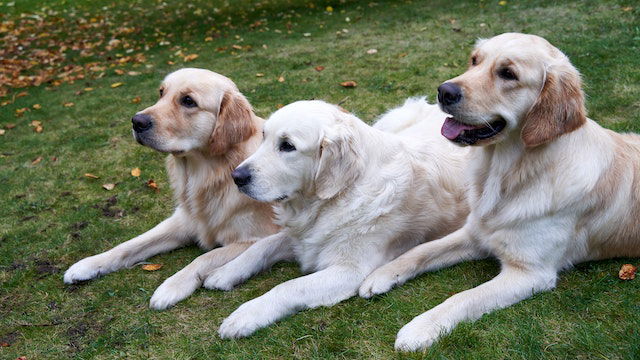
Lord Tweedmouth purchased a yellow wavy-coated retriever named ‘Nous’ in 1865 from a Cobbler in Brighton. He then crossed Nous with his Tweed Water Spaniel named ‘Belle’.
The resulting puppies were yellow, and they laid the foundation for the upcoming gundogs.
The Golden Retriever breed slowly developed by crossing the offspring with bloodhounds, tweed spaniels (now-extinct), Irish setters, and other retrievers as well.
Lord Tweedmouth would later give some of his colleagues and family the newly bred Retrievers to assist them in the hunting fields.
They had an impressive ability to recover game and waterfowl from the marshes and rivers in the vast terrains of Scotland.
The Golden Retriever was first registered in the American Kennel Club (AKC) in 1925, but they appeared in Britain 17 years earlier, in 1908, at the UK’s Crystal Palace.
Today, Golden Retrievers have found a special place in most homes as family dogs due to their loyalty, gentle demeanor, friendly nature, and eagerness to please their owners.
They are also used in fields by hunters, and they also work as therapy dogs in hospitals and elderly homes.
Are There Different Types of Golden Retrievers?
Yes! There are 3 major types of pure-bred Golden Retrievers. We also have several other crossbreeds of this breed line around the world.
While you may think that all Golden Retrievers are similar, the truth is that they have some genetic variations that alter some of their physical appearances.
What Are The 3 Purebred Types of Golden Retrievers?
The 3 purebred Golden Retrievers are identified by where they come from; America, Britain, and Canada.
All these Golden types can trace their ancestors from Tweedmouth’s water spaniel and his then newly acquired wavy retriever.
They share the same genetic makeup and ancestors. So, what makes the difference?
- The differences between the 3 purebred Goldens have evolved because of the geographical situation in these three places. This makes it easier for dogs in these places to breed with other native canines hence causing the slight differences.
- The Kennel Clubs in these countries have slightly different breeding standards. Therefore, the different breeders in these nations will only prioritize the traits that conform to their guidelines.
- Furthermore, some breeders will mix up different dog breeds to come up with a quality that is preferred for a specific purpose.
With that in mind, let’s jump in and look at these purebreds closely to see how they stack up against each other.
1. British Golden Retriever
History
British Golden Retrievers have their origin in Tweedmouth’s gundogs in Scotland. The carefully mixed offspring made their way to England and they were increasingly bred and used as show dogs to make appearances in dog competitions.
Appearance
The British Golden Retriever, also known as the English Golden Retriever, has a distinctive long-feathery coat that is lighter than the other two. Their coat appearance is both wavy and flat.
You will also notice a prominent ruff along the neck of British Golden Retriever and they are stockier and heavier than their American and Canadian brothers.

UK’s Kennel Club standards on Golden Retrievers have classified cream as a color, which is not the case for the American and Canadian standards.
Hence, the most noticeable difference between the British type of Golden Retriever and the other two is in the coat color.
Otherwise, these dogs are pretty similar in many other aspects including temperament and behavior.
2. The American Golden Retriever
History
The American Golden Retriever came into life during the early years of the 20th century when Americans noticed the popularity of the Goldens in England and other parts of the world.
A lot of cross-breeding between the early imported dogs and other existing retrievers gave rise to the now-popular, American Golden Retriever.
Appearance
The American version of the Golden Retrievers is darker, leggier, and less muscular than the other 2 brothers.
The American coat is characterized by a rich shade of golden color which is more easily recognizable than that of the British Golden.

Although they are darker in color than their English brothers, the American Goldens have a long, thick, and curly coat that repels water.
You will also notice a thick feathering around the tail, thigh, neck, and chest areas of the American Goldie.
The American type of Golden Retriever has lighter-colored eyes when compared to those of their British counterparts. Their almond-shaped eyes would typically appear triangular when viewed from the sides.
3. Canadian Golden Retrievers
History
Although the Golden Retriever’s great-grandfather – Saint John’s Dog of Newfoundland is from Canada, the Canadian Golden Retriever came from Scotland where all the others came from.
Archibald John Majoribanks, who is Tweedmouth’s son, is considered to be the first person who brought a Golden Retriever to Canada in 1881.
It was not until 1927 that the Canadian Kennel Club (CKC) registered its first Golden Retriever as a distinctive breed.
But before this time, the Golden Retriever was widely bred and raised in Canada to develop their desirable characteristics.

Appearance
Canadian Golden Retrievers are very much similar to their American brothers but with very minimal variations.
They have typically shorter, darker, and slimmer coats than those of their cousins from America and Britain. They also have less feathering on the forelimbs, around the neck area, and on the tail.
The Canadian breed standards for Golden Retrievers accept all shades of Gold as distinctive colors. You are therefore likely to see Canadian Goldens in a wide range of deep coat colors than the other two.
It’s important to note that all three Golden Retriever types are NOT hypoallergenic.
Golden Retriever Types Comparison Table
| Golden Retriever Type/Characteristic | American Golden Retriever | British Golden Retriever | Canadian Golden Retriever |
| Average adult body size | Males: 23 – 24 inches Females: 21.5 – 22.5 inches | Males: 22 – 24 inches Females: 20 – 22 inches. | Males: 23 – 24 inches Females: 21.5 – 22.5 inches. |
| Average adult weight | Male: 65 – 75 pounds Females: 55 – 65 pounds | Males: 65 – 75 pounds Females: 50 – 70 pounds | Males: 65 to 75 pounds Females: 60 to 70 pounds |
| Coat color | Shades of Gold | Shades of cream and Gold | Thin, short, and dark |
| Coat Appearance | Long, thick, and curly water-repellent coat.Heavy feathering around the neck and chest areas. | Flat, curly, & lots of feathering | Thin, short and dark |
| Eyes | Almond-shaped eyes | Large, dark, & rounded eyes | Slightly narrow-shaped eyes |
| Head | Broad | Blockish forehead | Broad |
Temperament
Despite having several differences in physical appearance, all types of Golden Retrievers have a similar temperament.
It is this desirable inherent personality that has made the Goldie a much-loved dog breed by many families across the world.
These dogs are loyal, gentle with children, affectionate to their owners, they love attention, and being in the company of others.
Golden Retrievers are also a go-to option for first-time dog owners because of their eagerness to please which makes them easy to train and keep.
Other Types of Golden Retrievers
The purebred Golden Retrievers have frequently been crossed with other dog breeds to create a new line of crossbred retrievers.
The pure-bred line has also been specially developed and raised to come up with Golden Retrievers with specific characters:
Some of the other types include:
1. Field Bred Golden Retriever
Field bred Golden Retrievers are what Tweedmouth had in mind when developing this breed back in the late 1800s.
These dogs are selectively bred for style, to use their instinctive hunting skills and high-energy drive as working dogs.
They are developed and reared for their tough flexibility, endurance, and high intelligence in the field.
Field Bred Goldies are the hunters’ favorite in recovering gunned-down game and they can also be used in field trials and agility competitions.
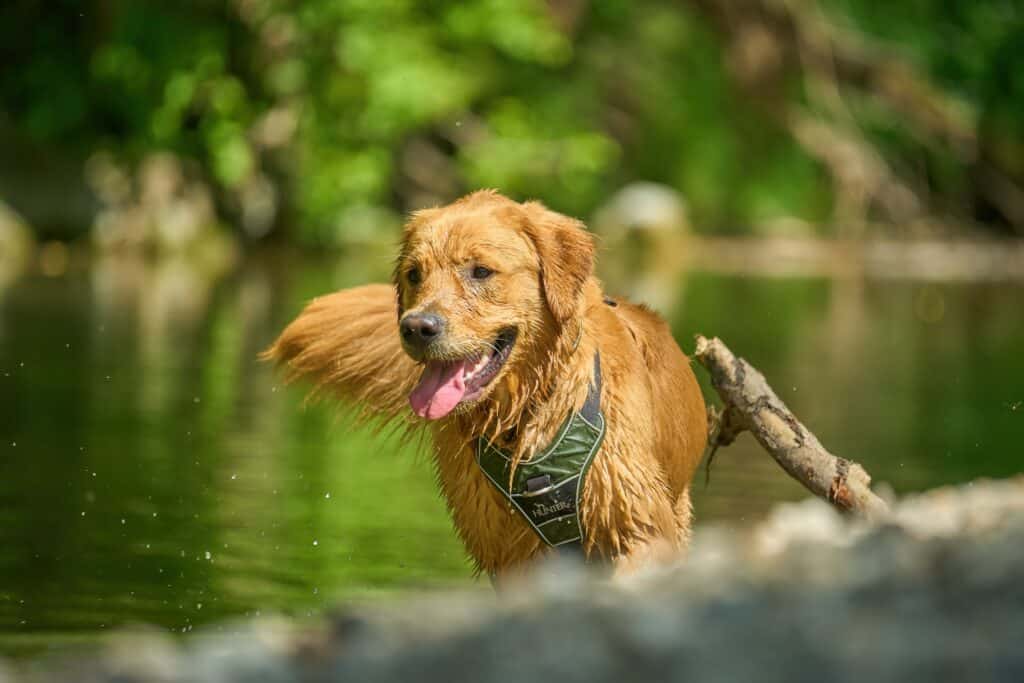
Golden Retrievers for field work have much leaner and more muscular bodies than other types. This is due to their intensive exercise and work. Their coat color exists in different shades of Golden and mahogany.
Their physical stature might be smaller than other Goldens with their males standing between 21-23 inches and females at a range of 21-22 inches.
Their adult males weigh around 60 – 70 pounds and their female counterparts weigh between 50 – 65 pounds.
2. Show Bred Golden Retrievers
Showbred Golden Retrievers are the opposite of field-bred ones. These flashy dogs are brought up for style to meet the exact requirements for the breed standards according to the overseeing Kennel Club.
Their owners’ aim is to take the elegant Goldens to dog shows and competitions. Many people have found show-bred retrievers to be calmer and friendlier than the other types.
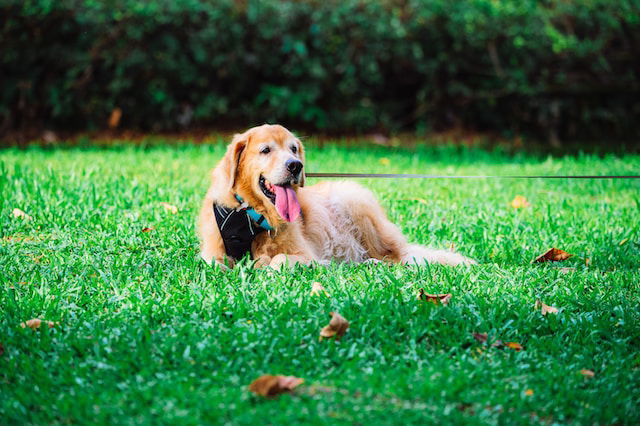
Since Golden Retrievers for shows are mostly developed for their physical attributes, they are large-boned with a stockier look, crowned with long coats, and a huge feathering along the fringes.
3. Mini Golden Retriever
These are not a small-sized true breed of Golden Retriever. They are rather a crossbreed of a Golden Retriever and a small size breed such as the Cocker Spaniels, Cavalier King Charles Spaniels, or Miniature Poodles.
Throwing a small breed dog into the mix always helps in creating a smaller hybrid that picks up on the desirable qualities of both parents.

Mini Golden Retrievers do not have specific requirements on coat color and type. The color can vary from faded cream to different shades of gold.
The coat appearance can also vary from straight to curly topcoat with feathering around the neck and tail.
Miniature Golden Retrievers stand at an average of 20 inches in height for both genders and they can tip the scale to between 30 – 50 pounds.
4. Black Golden Retrievers
Black is not an inherent color of any pure-bred Golden Retriever.
A Black Golden Retriever is therefore a mixed breed of the Golden Retriever with one of their close cousins – the Labrador Retrievers or the Newfoundlands.
These dogs have a characteristic tick undercoat with a long curly top coat which makes them visibly different from pure-bred Labs.

Black Goldens are medium to large sized and they don’t have a huge variation of traits since they have lots of similarities from both parents.
Both genders of this crossbreed can weigh anywhere between 50 – 70 pounds. When mixed with Newfoundlands, the resulting crossbreed will be much larger and can weigh up to 120 pounds.
5. English Cream Golden Retrievers
Also known as the Rare White European Platinum Retrievers, this dog is a close variation of the mainline English Golden Retrievers.
They were initially bred for dog shows and competitions in Great Britain during the early 1900s.
They have a distinctive pale-colored coat which makes them stand out from the other Golden Retrievers.
Most people admire the English Cream Goldens and they are mostly seen to have lovable personalities with sophisticated behaviors.
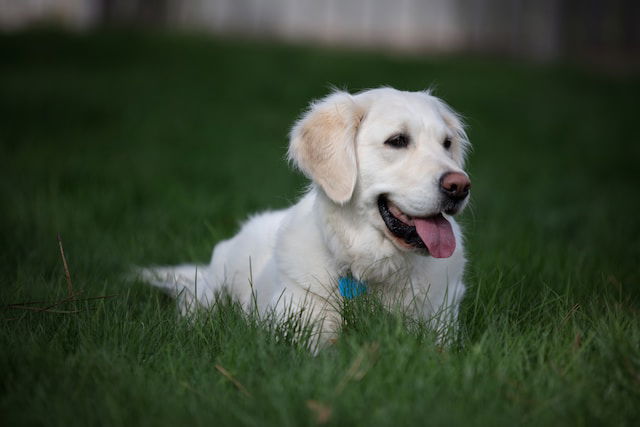
These dogs have a stockier body build with blocky heads and much thicker undercoats which translate to heavier shedding.
The males can measure between 21 – 24 inches in height whereas the females have a height distribution of 20 – 23 inches.
In terms of weight, the males are heavier at around 50 – 70 pounds and the females come in lighter at 45 – 70 pounds.
6. Red Golden Retrievers
Red Golden Retrievers have an eye-catching mahogany coat which declassifies them as pure-bred Golden Retrievers.
Red Golden Retrievers are mostly field-bred, which makes them highly motivated to work. Their energy levels are impressive which makes them a go-to option for people looking for field dogs.
Their top coat fur is also thinner and longer than that of the other types of Golden Retrievers.
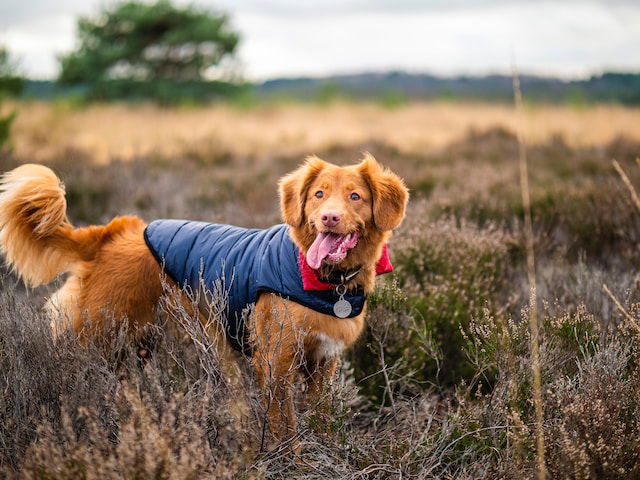
Red Golden Retrievers are often smaller in size with their males standing at 22-23 inches and females getting up to 21-22.5 inches tall.
A fully grown male can weigh between 65 -75 pounds and their female counterparts can tip the scale to between 55 – 65 pounds.
Which Golden Retriever Type Is the Best?
All pure breeds, style breeds, and cross breeds Golden Retrievers are ideal for a family setting.
You need to weigh your individual needs and pet preferences to determine which Golden Retriever will be your first choice among equals.
All the types have the same Golden temperament and somewhat different physical appearance which you may need to consider before choosing to adopt one.
Each dog may have their different maintenance costs that are needed to provide the best care and support in terms of providing the basic needs and exercises.
You can consult with a dog breeder or a qualified veterinarian to know which Golden Retriever type is ideal for your family and lifestyle.
Frequently Asked Questions
1. How do I identify the type of my Golden Retriever?
To identify the type of your Golden Retriever, you can look at their coat color, coat type (wavy or straight), feathering, and sometimes the color of the nose.
You can also look at the overall physical characteristics of the dog since some Goldens are less muscular than others, while others have well-built bodies.
Feel free to consult your breeder on the exact lineage and genetics of your desired dog before adoption or afterward.
2. What is the rarest type of Golden Retriever?
This has to be the English Cream Golden Retriever which has its origin in the mainline British Golden Retriever.
This Golden dog is characterized by a pale coat with a cream color that makes it stand out from the rest.
Their distinct color makes them appear unique compared to the traditional gold-yellow color of most Golden Retrievers.
3. Do all Golden Retriever types shed the same?
All Golden Retrievers, regardless of their subtypes, will shed their fur year-round. They have a double coat which consists of a heavy undercoat and a slimmer top coat.
Heavy shedding will be observed in the closing months of fall and spring when the dog is preparing for major seasonal changes.
Conclusion
There are 3 main purebred Golden Retrievers but we also have several crossbreeds.
All types of Golden Retrievers are instinctively similar, but they only differ in a few physical characteristics such as coat color, coat type, and body size.
You can always inquire about the lineage of your Golden Retriever before adopting to gauge their inline physical characteristics as they grow.
Laura is the founder of Furs'n'Paws. She is a also a pet writer and expert with more than 20 years of experience of working with dogs and cats. She developed a very strong love for animals at a young age. Her passion led her to establish a thriving pet sitting and dog walking business in Dubai. As an expert in pet training, behavior, and nutrition, Laura is committed to helping pet owners and pet lovers by offering high-quality information on a wide range of topics.



No responses yet